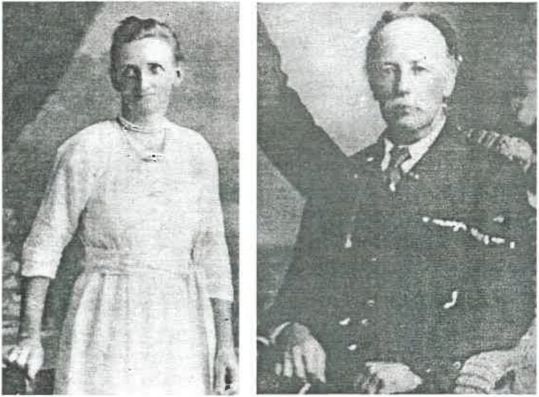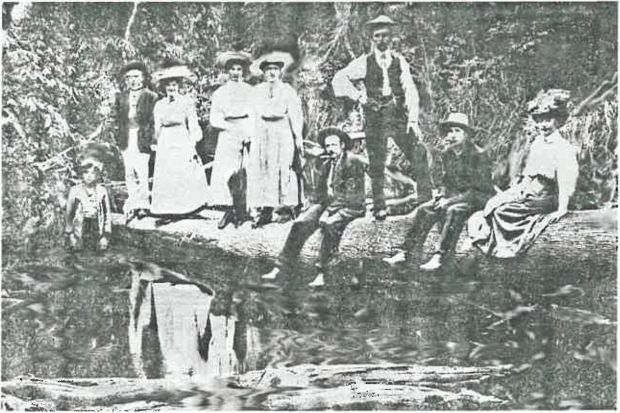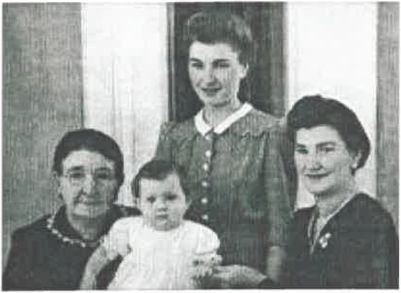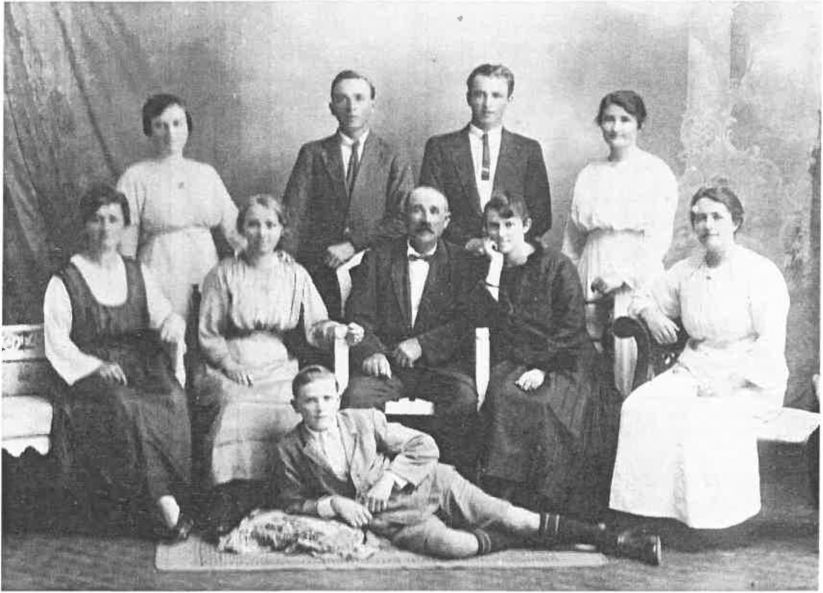The
following families are those who enrolled some or all of their children
at the Goodwood Provisional School in October 1900. Most are pictured in
the 1901 photograph.
Moffatt
Marion [11], Maggie [9] and John Moffatt [5] have the honour of being the first three students enrolled at the new school. Robert began
in 1902. Their father David Moffatt was the Station Master, in charge
of the staff including the lengthsmen, gangers and fettlers who were
also employed by the Railways. The family arrived at Goodwood in early
1900, the children travelling by train to Howard for their schooling
until the Goodwood School opened. The Moffatt’s occupied the
Railway House, which was built about the same time as the Railway
Station in 1887. Mr Moffatt was involved with the school committee
serving as Secretary for some years. The family left for Inglewood in
1908.
Maggie Moffatt [Carter] wrote to the 75th Jubilee committee in 1975:
"On reading the
Courier this morning, my mind was taken back about 74 years ago. Happy
we were at Goodwood where we were taught to respect our teachers. Indeed
it was there that the foundation was laid for what I was to
go through in life. I can truly say that on looking back with affection
to school and all the class-mates, we were fortunate to have started
life under such a good influence... Miss Jessie Price was the
schoolteacher, coming from Bundaberg by train, keeping her bike at the
station and riding to and from school. My father was David Moffatt,
Station Master at Goodwood. We walked four miles to and fro the school.
I'm now 84 years of age and I live with my sister who was one year old
when we left Goodwood. We are the last of the family. Wishing everyone
a lovely day with lots of happy memories."
Signed Margaret Carter [nee Moffatt] September 1975
Binnington
There were at least eight children in the family,
six attending Goodwood School. Their father, Samuel Binnington was a
Lengthsman at the Railway Station, his wife Hannah, the Station
Mistress. The family was at Goodwood as early as 1895, when their
children, Robert, Annie and George's names appear on the Howard State
School register as students travelling by train from Goodwood. William
followed in 1897, Martha and Edward in 1899 and 1900. Robert
Binnington’s daughter, Mrs Sylvia Hall of Woodgate writes … “My
Dad travelled by train to school in Howard, and also went by train to
pick up bread and groceries from Bundaberg. When he was ten, he went
with another fellow to Woodgate [presumably on an old German wagon] to
collect empty beer bottles etc. This was about 1895. When my grandmother
Hannah Binnington was due to
give birth to one of her babies, my grandfather Sam went by trolley or
pumper [along the railway] to bring a doctor to attend to the birth of
the baby."
When the new school opened on October 18lh 1900, George [12], William [8], Martha [7] and Edward [5] Binnington enrolled at Goodwood School, followed by Florence in 1902 and Nellie in 1903. The family is said to have moved to the Kingaroy district in 1903. Both Edward [Ted] and Nellie attended the 75th Jubilee in 1975, both being survived by children in the Maryborough area. [Mrs Irene Thompson and Mrs Joan Van Itallie]
Leeson
Tom Leeson [born 1866] married Bertha Thoms at
her parents' home at Goodwood in 1888. They selected land on the
southern side of the Gregory, building a slab hut for their home. Bertha
[born 1866] was a daughter of Carl Thoms Sr. Tom Leeson worked at
the Goodwood Plantation, and like most men of his era, was adept at many
trades, working as a butcher, farmer and miner at various times. Above
all he was a highly experienced horseman.
The couple had fourteen children, the four eldest, Emily [11], Thomas [8], Florence [7] and Jessie [5], enrolling at Goodwood School on the first day. Progressively, the remaining children, Agnes, William, Ted, George, Charles, Ada, Robert, Archie, Eileen and Phyllis, were all educated at Goodwood as were many of their descendants who are still living in the district today.

Above: Bertha Leeson nee Thoms ca. 1888. Above: Tom Leeson
[Photos courtesy Mrs Gert Leeson]
Tom Leeson [Sr] was one of those present at the
inaugural school meeting in 1899, serving on the Committee as Chairman
from October 1903 until 1908, when he was elected as Treasurer. In 1918,
in his tenth continuous year as Treasurer, he donated a horse to the
committee for a raffle prize, the funds going to the war effort.
However, in September that year, he was accidentally killed when his
horse reared up and struck a tree. He was 52 years old. At the time of
his death, Tom was serving his 19th continuous year as a member of the
School committee.
After his death Bertha went on to raise their
younger children by working as a cook at Moolboolaman Station near Mt
Perry. In later years she lived in Bundaberg with son Ted until her
death in 1960 at age at 94 years.
At the time of writing, Ada [Lockwood] and Robert
[Bob] Leeson are the only surviving children of Tom and Bertha, Ada
living in Mackay, and Bob at Goodwood. Leeson descendants are numerous,
many living in the Isis and including three great-great-grandchildren
still attending Goodwood State School who are all fourth generation
students; cousins Mathew and Kirsty Sommer, and Jenna Bauer.
Heinrich F.L. Rackemann
Louie Rackemann was born in Germany in 1855. At
age 26, he emigrated to Australia with his younger brother Friedrich
[Fred] Rackemann aged then 18, followed in 1884 by their parents and
several of their family. Their father, who was 61 years old when he
arrived in Australia, died in 1894 and was buried in a pauper’s grave in
Maryborough.

ABOVE - The Family of Louie Rackemann - ca 1910
FROM LEFT REAR: Edward, Freida, Martha, Millie, Edna, Annie, Elsie, Rosalie. FROM LEFT FRONT: Mr Louie Rackemann, Hilda Mrs Amalie Rackemann
[Photo courtesy Mrs Gloria Rehbein, Bundaberg]
Louie Rackemann married Amalie Taebke in 1889.
Both brothers and their widowed mother selected land in the 1890’s on
the Gregory River east of the railway line. First was Fred in 1893,
followed by Louie in 1895, who selected 116 acres on the south side,
opposite Fred’s earlier selection on the north (currently belongong to the Draper family).
Their widowed mother Johanna and her remaining children selected land a
few months later, further east of Fred’s property. The only evidence of
their home is two mango trees about three kilometres down Woodgate Road
on the right. Gustave and Jean Burow and their son Angus later lived
there.
Eight of Louie and Amalie Rackemann’s nine
children attended Goodwood school over the years. Annie [10] and Eliza
[8] were two of the foundation pupils, followed by Amelia [Millie] and
Rosalie in 1901, Martha in 1904, Edward in 1906, Freida in 1909 and
Hilda in 1911. Annie attended Howard State School from 1897 prior to
enrolling at Goodwood. Edna, the youngest, was one year old when the
family left Goodwood in 1912. As well as farming, Louie worked as a
bricklayer, helping to construct such buildings as the Grand
Hotel Childers, and in Bundaberg, the Police Station, Post Office,
Linden House, Catholic Church and East End water tower. Amalie Rackemann
was instrumental in the process of fund-raising to build the school.
Despite all the privation of pioneering life, Amalie Rackemann always
managed to look her best, being especially fussy about the appearance of
her hair. She must have been a very capable woman, for Louie was often
away for weeks at a time, leaving her at home alone with the children.
Her grand-daughter, Gloria Rehbein, [daughter of Martha Rackemann]
recalls her grandmother saying that on some occasions, as soon as Louie
caught the Sunday evening train to Bundaberg to go to work, two
Aboriginal men would come to her door asking for sugar and tobacco.
Amalie Rackemann also acted as a local midwife and nurse. Mrs Rehbein writes … “Pastor Hellmuth (a Lutheran Minister, whose wife was a sister of Johanna Rackemann [Fred & Louie's mother]) would sometimes break his journey and stay overnight with my grand-parents on his way between Maryborough and Bundaberg. He was able
to teach Amalie about some homeopathic medicines. This she found very
helpful in looking after her large family and other friends … People
she often mentioned helping were the Burow and Leeson families. Arnica
was a great standby for various cuts … Another remedy was Aconite, used to bring down fevers, and she always kept Belladonna on hand, plus other poultices for various things"…
As there was no bridge over the Gregory then,
Louie felled a large tree across the river so the family could cross
more easily, smoothing the upper surface of it to make it safer. This
crossing was near their home east of the railway, enabling easy access
between the three families’ homes. Amalie would lead the little ones
over it when it was raining because they were fearful of slipping. The
tree still lies where it was felled by Louie, adjacent to a natural
crossing used frequently by the Draper family, [see photograph in Draper
article].
The photograph below of a group at the Gregory, has the following notes written on the back...
“On a Sunday walk taken on the Gregory River 1910.... Miss Dawson, [far right] a neighbour, rode to our home dressed as she was. She rode astride with her skirt split up the centre and back, and could unbutton it when she rode. Ed Rackemann, [far left] with his crews, stroked and won many [rowing] championships for Bundaberg, and won the Ernest Winter shield”.
 ABOVE: from
left … Edward Rackemann, Mr Cyril Zander, Mrs Annie Zander [nee
Rackemann], Mrs Eliza Beatson [nee Rackemann], Mrs Millie Dickson [nee
Rackemann], Mr Jack Beatson, A friend, Mr Dawson, Miss Dawson.
ABOVE: from
left … Edward Rackemann, Mr Cyril Zander, Mrs Annie Zander [nee
Rackemann], Mrs Eliza Beatson [nee Rackemann], Mrs Millie Dickson [nee
Rackemann], Mr Jack Beatson, A friend, Mr Dawson, Miss Dawson.

ABOVE: Four generations of Rackemann women in 1942.
From left: Amalie
Rackemann [wife of Louie Rackemann] Robyn Rehbein; Gloria Rehbein [nee
Stoward]; Martha Stoward [nee Rackemann], Goodwood student 1904-12]
All photos courtesy Mrs G. Rehbein
Edward Rackemann, Louie and Amalie's only son, lived to the age of 74 and is buried at Toogoolawah cemetery near Kingaroy. In 1932, Edward married Caroline Waibel, and together they had 6 children, including a son also called Edward.
Louie Rackemann died in 1930 aged 75, his wife Amalie dying in 1960 aged 91.
Friedrich C.H. Rackemann
Fred Rackemann, born in Germany in 1864, was 18 when he arrived in Australia with his
brother Louie in 1882. Fred married Ida Stolznow, a tall and striking
woman who had been bom at sea of German parents, and selected 116 acres
of land on the north side of the Gregory at Goodwood in 1893.

ABOVE - Fred Rackemann and Family - ca 1918
From Left, standing:
Ann Bauer, George Rackemann, Fred Rackemann [Jr], Betty Dwyer. Sitting:
Eleanor [Tottie] Patterson, Marie Christiansen, Fred Rackemann, Vena
Aitken, Helen Harch. Floor: Ernest Wilhelm [Bunny].
Photograph courtesy
of Mrs Dorothy Loder.
His mother and remaining siblings selected
another 160 acres of land east of Fred’s in 1895. Sophie Voges, their
older sister, also resided at Goodwood, her daughter Frieda attending
Goodwood School. Three of their brothers, Harry, George and Ernest,
later left the Isis and selected land in the Wondai district. Carl
Rackemann, Ernest's grandson, played Test Cricket for Australia.
In the late 1890's, Fred and Ida became concerned
about their children's education, and so Fred leased a cane farm at
Cordalba, the family moving there, and the children attending Cordalba
School. However when the Goodwood School opened in October 1900, the
Rackemann family returned to their Goodwood farm. Fred and Ida enrolled
their school-age children at Goodwood in 1900. They were Helena [Ellen]
10, Eliza 7 and Charles [Karl] 8, followed in January 1901 by George
[5], the first child to be bom at Goodwood. Annie and Mary followed in
1902 and 1904 respectively.
Kanakas employed by farmers at that time usually
lived and ate in separate buildings [barracks], but according to the
late George Rackemann, the Kanaka man employed by their family at
Goodwood ate at their table and used their Christian names when in
conversation, a practice not always appreciated by other white families.
Concern over their children’s religious education prompted the family’s
move to Bundaberg in 1904. Mrs Ida Rackemann died in 1908, after which
time Fred remarried, producing three more children, Bernard [Harry],
Godfrey and Charles. Fred was apparently an inventive person, in 1911
designing and building a horse-drawn haul-out wagon which did away with
the need for portable rails. He is thought to have died in 1928.
Bernard Rackemann,
lived for a time on a property several hundred metres from the school
on Woodgate Road with wife Ellen and their family. Their children Alan and Joan enrolled at Goodwood State School in 1942 and 1943.

Mr & Mrs George Rackemann 1957. Courtesy of Mrs D. Loder
George Rackemann was a guest of honour at the school’s 75th
Jubilee. In 1923, George had married Kirsten Enid Stephenson, and moved
back to the Isis to farm. In the late thirties, due to his failing
eyesight, they moved to Childers, operating a guest house for seventeen
years.
When interviewed in 1975 for the Jubilee, George
stated that the price for cane around 1900 was 7/6 per ton. In the 1902
drought, George helped his father cart timber to the Rafting Ground on
the Gregory, where logs were floated down to the river mouth. George,
then aged 7, had the job of tending the horses while the men worked. His
daughter Dorothy Loder recalls George saying that families then were
self-sufficient. For example, her father built a smoke-house and corned
their own meat, made an ant-bed oven for baking bread, and picked up
down to fill home-made mattresses.
George Rackemann passed away in 1985.
Burow
Three generations of the Burow family lived at
Goodwood for a period of approximately 60 years. In 1899, Christian
Burow is named in the minutes as a member of the school building
committee, and was also the successful tenderer for the original
clearing and fencing of the school’s land, serving as a school Committee
member for a number of years.

Above - The
Burow family ca. 1920, Standing from left: Lily Burow, Fred Burow, Jean
Burow Sitting: Christian Burow, Auguste Burow [nee Thoms] On grass:
Angus Burow
[Photos courtesy Mrs Kath Burow]
Christian and his wife Auguste [nee Thoms, a
daughter of Carl Thoms senior and sister of Bertha Leeson], lived about
one kilometre south-east of the school, behind what is now Galley's
property. It is said that three Burow children and one Mackelmann child
were buried on the property. Prior to the Goodwood school opening, their
children Gustav, Lena, Annie and Edith Burow all attended Howard State
School, travelling by train from as early as 1897. Annie [12] and Edith [6] were among the first to attend Goodwood School in October 1900. William then started in 1902, followed by Frederick who attended from 1905 to 1910, then Lily, 1912
to 1921. In the 1930's, Frederick Burow and his wife Beatrice [Larder],
lived in a low-set dwelling a short distance north of the school. Their
three children, Donald, Kevin and Beryl, also attended Goodwood school between 1933 and 1942.
Gustav Burow’s son Angus attended Goodwood from
1317 to 1922 . Gustav, his wife Jean [nee Larder] and Angus lived in a
four-roomed home with a dirt floor on Woodgate Road about three
kilometres east of the railway line in what had previously been the home
of Johanna Rackemann. Gus and Jean worked at Hapsburg Plantation where
Gus was a labourer, ploughing the land, planting cane and cutting it in
the crush, while Jean worked in the cookhouse doing the cooking for the
workers who stayed in the barracks. Angus, who was great mates with Vic
Mackelmann, also worked as a labourer at Hapsburg after he left school
at age 13. During the Depression, one went where the work was, and so
Angus and Vic rode their bicycles to Roma for a job ring-barking trees
to dear land. They camped out in the bush, fresh food being brought out
to them every few days. No doubt the productive land in that area can be
attributed to the work done by men like them.
Angus and his wife Kath both attended the school’s 75th Jubilee in 1975. Angus Burow died in 1993.
Gibson
Roland Gibson was 8 years old when he was
enrolled at Goodwood School in 1900. His father was listed in the school
register as Selector who owned the farm which has been in the Oliver
family for many years. He also worked at the Plantation. Mr Gibson must
have been fairly well educated, for he was the first Secretary of the
School Building Committee, writing many letters to the Department,
copies of which are still in the school’s possession. Roland left
Goodwood School in 1902.
Evans
Dorothy Evans aged 6 and her sister Margaret,
aged 5, both began school in 1900. Mabel, commenced in 1906, followed by
William in 1909. Their father was W.J. Evans, who was manager of the
Goodwood Sugar Mill from 1897 to about 1912. He served on the Committee
for several years, including one year as Chairman.
Ambrym
A South Sea Islander, Florrie Ambrym was 10 when
she began school in 1900. Although the records state that she was an
Islander, Florrie was probably bom in Australia of Islander parentage.
Many Kanakas took on the surname of the island of their birth and so it
is presumed that one or both of her parents came from Ambrym Island,
Vanuatu. Her parents] would have worked at the Goodwood Mill and
Plantation, where up to 40 Kanakas worked at one stage. For reasons
unknown, in early 1901, Miss Dodd wrote to the Department seeking
Florrie’s suspension from school. Apparently this did not occur, and in
the 1901 photograph, Florrie appears to be a well dressed young lady,
mixing easily with the other children. She left Goodwood School in
December 1902, leaving no trace but for a face in a photograph. As most
Kanakas were deported to their homelands by 1905, it is probable that
she too ended her years back in the islands with her family.
Early families, some of whose children attended Goodwood School
[Reprinted from “A History of Goodwood and Woodgate" - E. Bucldand 1985]
MELVILLE - Camped in a tent and worked on the Railway. [1901]
O’MALLEY, JOHNSON, Charlie TYSON, and Jimmy O’DWYER - were all labourers working at the Plantation.
OBA - A Kanaka. Son Jack was a “real trick”. [1902]
RYAN - Railway employee [1902, 1903]
SCHLEGER - Operated a shop in a little tin shed. [1916]
KINGSTON - Established the citrus orchard on the property [previously] owned by Jarrett’s. [NB., Jarretts Road subdivision].
BURGESS - Bill was a teamster.
His horse team worked the land for planting and at crushing time, carted
bags of sugar to the Railway Station. [1911]
PEGG - Tom. Also a teamster [1907, 1909]
LOESKOW - General farm stockman. lived on Sandy Flat between the Plantation and Peirson’s.
STOLLZNOW - Had a cane and mixed farm north of Peirson’s. [1908, 1909]
PEIRSON - English people. Four
daughters, one married Mr Mohr. A second daughter drowned in the
Gregory. The last two surviving daughters willed all their land etc. to
the Presbyterian Church.
PALM - Operated the Goodwood
Store and also had a cane farm, [now Mackelmann’s] The family later
moved to Bundaberg and established the automotive business known as
“Palm Centre”.